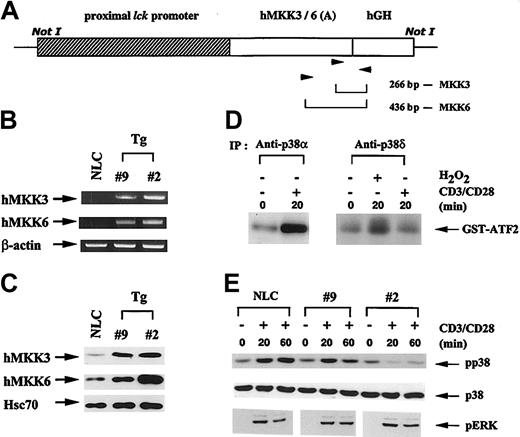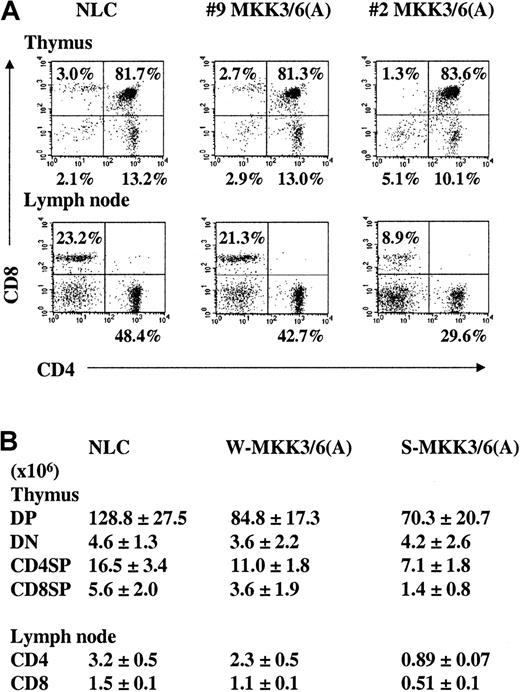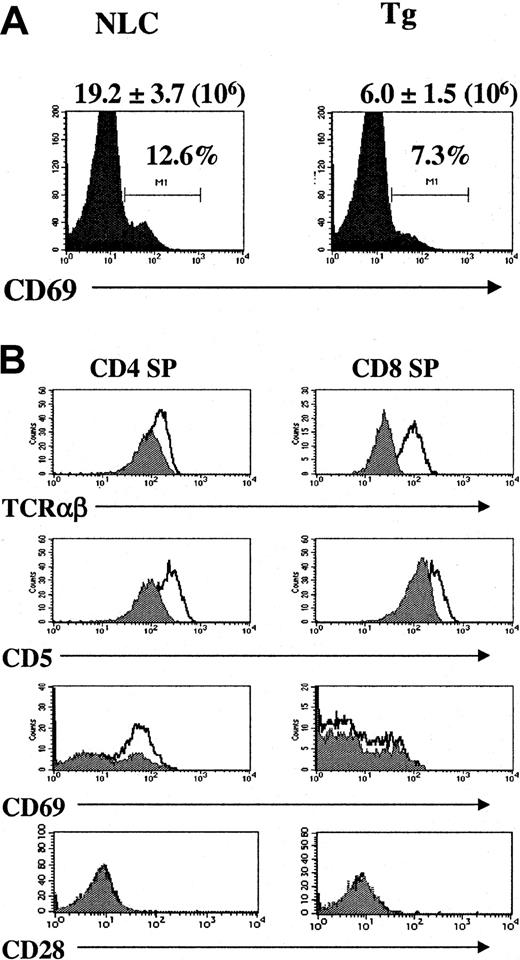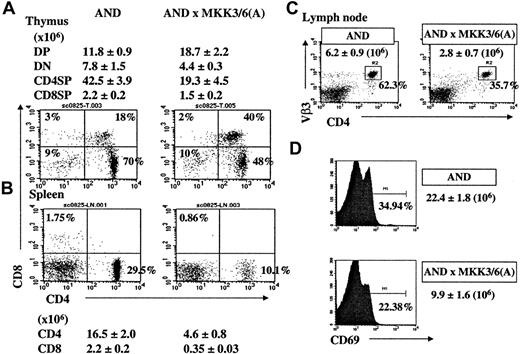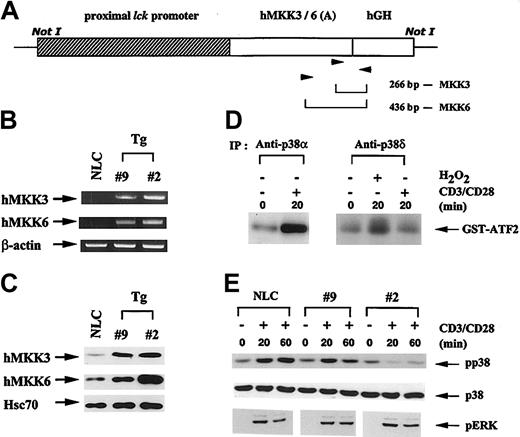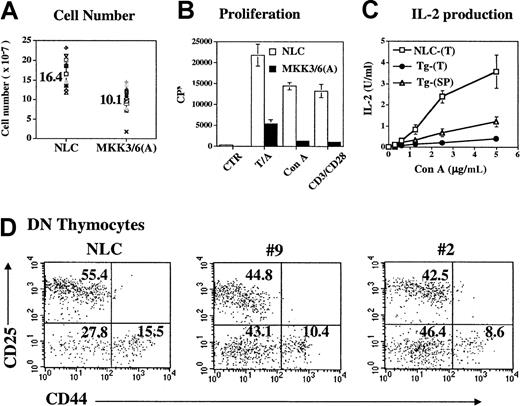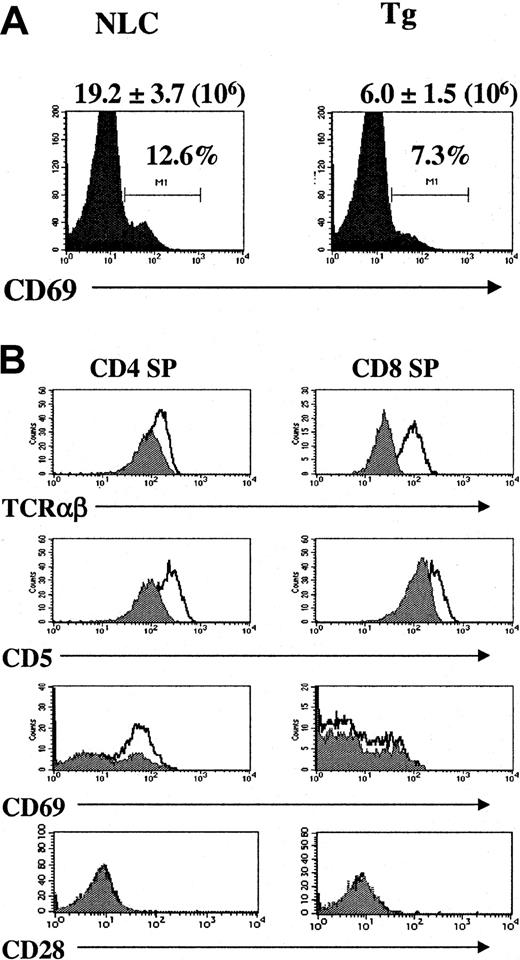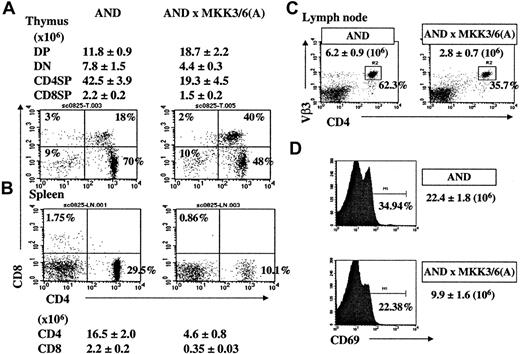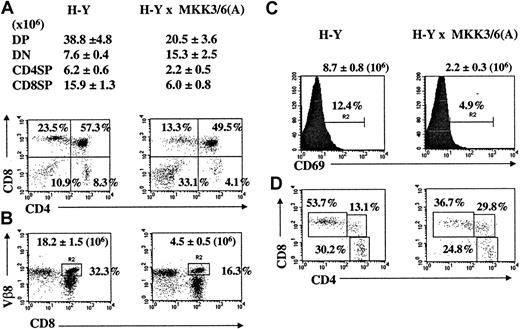Abstract
Positive selection of thymocytes during T-cell development is mediated by T-cell receptor (TCR)–activated signals. For different mitogen-activated protein kinases (MAPKs) activated by TCR complex, a selective involvement of extracellular signal–regulated kinase, but not p38 MAPK, in positive selection has been suggested. Using transgenic mice with dominant-negative mutation of both MAP kinase kinase 3 (MMK3) and MKK6, we obtained mice with different extents of inhibition of p38 MAPK activation. Partial inhibition of p38 MAPK impaired CD4−CD8− thymocyte development and T-cell proliferation, but not positive selection. Interference with thymocyte positive selection was observed in mice with effective suppression of p38 MAPK. Our results suggest that, in addition to early thymocyte development, p38 is involved in positive selection.
Introduction
p38 Mitogen–activated protein (MAP) kinase, originally identified for its response to stress stimuli, is activated by ligation of T-cell receptor (TCR) and costimulatory molecules.1-7 p38 MAP kinase (MAPK) is specifically activated by MAP kinase kinase 3 (MKK3) and MKK6.8-13 Of the 4 isoforms of p38 MAPK, p38α and p38δ are the major isoforms in T cells.14,15 We have previously found that TCR/CD28 engagement activates p38α but not p38δ.6
Successful T-cell development is dependent on signals activated by pre-TCR and TCR complexes. Assembly of pre-TCR after rearrangement of the TCR β-chain triggers the development of early CD4−CD8− (double-negative, DN) thymocytes into CD4+CD8+ (double-positive, DP) thymocytes. Following TCR α-chain rearrangement and TCR αβ dimer expression, the interaction of TCR with self-major histocompatibility complex (MHC)–peptide complex promotes the differentiation of DP thymocytes into CD4+CD8− and CD4−CD8+ single-positive (SP) T cells, a process known as positive selection.16 Many TCR proximal signals are involved in thymocyte selection.17,18 Of the 3 major MAPK cascades, the extracellular signal–regulated kinase (ERK) pathway is known for its involvement in positive selection.19,20 Inactivation of the ERK1 gene results in defective positive selection.21 Detailed analysis reveals that ERK is selectively activated during positive selection.22,23 In these studies, no activation of ERK was detected in thymocytes failing to undergo positive selection, whereas p38 MAPK and c-Jun N-terminal kinase (JNK) remained activated. It is therefore suggested that the activation of p38 MAPK and JNK is dissociated from positive selection. For JNK, studies conducted using mice deficient in both JNK1 and JNK2 indicate that T-cell development indeed does not require JNK.24
p38 MAPK has been shown to participate in early thymocyte development,25,26 yet conflicting results were obtained as to the role of p38 MAPK in positive selection. By using fetal thymic organ culture and SB 203580, the pharmacologic inhibitor of p38 MAPK, one study indicated that p38 is not required for positive selection,27 whereas another study illustrated that SB 203580 prevents positive selection.28 SB 203580, however, inhibits both thymic T cells and thymic stroma cells, so the controversy about whether TCR-activated p38 MAPK is involved in positive selection cannot be directly addressed by using thymic organ culture. Transgenic expression of the dominant-negative p38α in T cells does not affect positive selection25,29; however, p38 MAPK activity was reduced by only 50%.25 T-cell development is normal in MKK3-deficient mice,30 likely because of compensation from the intact MKK6 for p38 activation. A similar prediction could be made for MKK6−/− mice. Genomic inactivation of p38α is usually lethal to the embryo.31-33 In the present study, we have used T-cell–specific expression of the dominant-negative forms of both MKK6b and MKK3b to effectively suppress p38 MAPK in thymocytes. Our observations reveal an impaired positive selection of T cells in the absence of p38 MAPK activity. Our results provide the first direct evidence that p38 MAPK is involved in thymocyte-positive selection in vivo and suggest that both ERK and p38 MAPK are TCR downstream signals that mediate positive selection of thymocytes.
Materials and methods
Reagents and cell lines
Concanavalin A (Con A), 12-O-tetradecanoylphorbol-13-acetate (TPA), and A23187 were purchased from Sigma Chemical (St Louis, MO). SB 203580 was purchased from Calbiochem (San Diego, CA). The following antibodies were purchased from Caltag (Burlingame, CA): mouse CD4 (clone CT-CD4, fluorescein isothiocyanate [FITC]– or TRICOLOR-conjugated), CD5.2 (clone CG16, FITC-conjugated), CD8 (clone CT-CD8a, phycoerythrin [PE]– or TriColor-conjugated), CD44 (clone IM7.8.1, FITC- or PE-conjugated), CD69 (clone H1.2F3, FITC-conjugated), and TCR (H57-597, FITC-conjugated). FITC-conjugated anti-CD25 (clone PC61.5.3) and FITC-conjugated Anti-Vβ3 (KJ25) were obtained from PharMingen (San Diego, CA). PE-conjugated anti-CD4 (GK1.5), FITC-labeled anti-CD8 (53-6.7), PE-conjugated anti-CD25 (clone PC61.5.3), and PE-conjugated anti-CD69 (clone H1.2F3) were purchased from eBioscience (San Diego, CA).
Plasmids
Construction of the dominant-negative mutant of p38α (p38α[Ala180, Phe182], p38α[AF])34 and the dominant-negative mutants of MKK3b (MKK3b[Ala218, Ala222], MKK3b[A]) and MKK6b (MKK6b[Ala207, Ala211], MKK6b[A])35 has been previously described. p1017 containing lck 3.2-kb proximal promoter and 3′-untranslated region of human growth hormone (mini gene exons 1-5) was a gift from Dr Roger Perlmutter (University of Washington, Seattle). Human CD2 cassette was a gift from Dr Dimitris Kioussis (National Institute for Medical Research, London, United Kingdom). Transgenic mice were generated in the transgene/knockout core of the Institute of Molecular Biology, Academia Sinica (Taipei, Taiwan, Republic of China). The 5.5-kbBamH1-XbaI fragment containing the CD2 locus control region36 was isolated and coinjected with p1017-MKK3(A) and/or p1017-MKK6(A) into the pronuclei of C57BL/6 zygotes.37 Nine independent founders were obtained. All transgenic mice were maintained in the specific pathogen–free (SPF) mouse facility of the Institute of Molecular Biology, Academia Sinica. Animal experiments were conducted with the approval of the Animal Committee, Institute of Molecular Biology, Academia Sinica.
Immunoblot
Cell extracts (10-30 μg) were resolved by 10% sodium dodecyl sulfate–polyacrylamide gel electrophoresis (SDS-PAGE) and transferred to polyvinylidene difluoride membranes (Millipore, Bedford, MA) for 4 hours at 20 V. Membranes were washed in rinse buffer (phosphate-buffered saline with 2% Tween 20) at room temperature for 15 minutes and incubated in blocking buffer (5% nonfat milk in rinse buffer) for 1.5 hours. The membrane was then incubated with anti-p38α antibody C-20 (Santa Cruz Biotechnology, Santa Cruz, CA), antiphosphorylated (T180/Y182) p38 MAPK antibody (Cell Signaling, Beverly, MA), anti-MKK3, or anti-MKK6 antibody34 for 2 hours at room temperature and afterward washed 3 times with rinse buffer. The membrane was then incubated with 1:1000 diluted horseradish peroxidase–conjugated antirabbit immunoglobulin antibody (Santa Cruz Biotechnology), followed by development with enhanced chemiluminescence reagents (Amersham, Buckinghamshire, United Kingdom).
Protein kinase assay
Thymocytes were treated with anti-CD3/anti-CD28 or hydrogen peroxide. Cell lysates were prepared 20 minutes after activation, and 100 μg lysate was precipitated with 1 μg anti-p38α or anti-p38δ antibodies,38 followed by 20 μL protein A–Sepharose (Pharmacia). The kinase activity of the immune complexes was determined using GST-ATF-2 (1-109) as substrate. The reaction mixtures were resolved on SDS-PAGE, subjected to autoradiography, and quantitated by PhosphorImager (Molecular Dynamics).
Results
Generation of lck-MKK3b(A)/MKK6b(A) transgenic mice
We constructed transgenic mice with the dominant-negative mutant of p38α, p38α(AF). p38α activation was suppressed by 30% to 50% in lck-p38α(AF) (data not shown), an effect similar to that previously reported from experiments using transgenic mice with a dominant-negative p38α.25 We were unable, however, to inhibit more than 50% of p38α activity by p38α(AF) in several transgenic attempts. Consequently, because p38α is activated by both MKK3 and MKK6, we used transgenic expression of MKK3b(A) and MKK6b(A), the dominant-negative forms of MKK3b and MKK6b, for more effective inhibition of p38 activation. Both MKK3b(A) and MKK6b(A) were subcloned into p1017 vector with lck proximal promoter (Figure1A). We coinjected lck-MKK3b(A) or lck-MKK6b(A) with CD2 locus control region.37 The generated transgenic founders were then bred to produce mice with both MKK3b(A) and MKK6b(A). We also produced MKK3b(A)/MKK6b(A) double transgenic mice by direct microinjection of lck-MKK3b(A), lck-MKK6b(A), and CD2 locus control region. Simultaneous expression of MKK3b and MKK6b in the double transgenic mice produced by either method was confirmed by reverse transcriptase–polymerase chain reaction (RT-PCR) (Figure 1B). Total MKK3 and MKK6 protein expression was elevated in transgenic mice (Figure 1C). Variation in the expression levels was found between different transgenic lines.
Generation of lck-MKK3b(A)/MKK6b(A) transgenic mice.
(Panel A) Schematic representation of the MKK3b(A)/6b(A) transgene. MKK3b(A) and MKK6b(A) were subcloned between the proximal lck promoter and human growth hormone (hGH) polyadenylation signals and intron sequence. Arrowheads indicate the locations of the transgenic-specific PCR primers. (Panel B) RT-PCR analysis of MKK3b(A) and MKK6b(A) transgene expression in peripheral lymphocytes. mRNA prepared from peripheral blood lymphocytes of 5-week-old MKK3b/6b(A) transgenic mice and normal littermate control (NLC) was amplified using the transgenic-specific PCR primers. The PCR products were resolved using agarose gels. (Panel C) Expression of MKK3b(A) and MKK6b(A) proteins in transgenic mice. The expression levels of MKK3 and MKK6 protein in thymocytes from MKK3b(A)/6b(A) transgenic mice and NLC mice were determined by immunoblots. (Panel D) T-cell activation stimulates mainly p38α. Thymocytes were rested for 4 hours after isolation from mice and then stimulated with immobilized anti-CD3 (10 μg/mL) plus anti-CD28 (2.5 μg/mL) or hydrogen peroxide (500 ng/mL). Lysates were prepared 20 minutes after treatments, and the kinase activity of p38α and p38δ isolated by immunoprecipitation was determined using GST-ATF-2 (1-109) as substrate. (Panel E) Inhibition of p38α activation in different lck-MKK3b(A)/MKK6b(A) transgenic mice. Rested thymocytes from NLC, line-9, and line-2 transgenic mice were stimulated with immobilized anti-CD3 (10 μg/mL) and anti-CD28 (2.5 μg/mL) for 20 minutes and 60 minutes, respectively, and cell extracts were prepared. The contents of the phosphorylated p38 MAPK (pp38) and the total p38α MAPK were determined by immunoblots using anti–phosphorylated T180/Y182 p38 MAPK antibody (Cell Signaling) and anti–p38α C-20 (Santa Cruz Biotechnology), respectively. Activation of ERK was used as an internal control using anti–phosphorylated T202/Y204 ERK (Cell Signaling).
Generation of lck-MKK3b(A)/MKK6b(A) transgenic mice.
(Panel A) Schematic representation of the MKK3b(A)/6b(A) transgene. MKK3b(A) and MKK6b(A) were subcloned between the proximal lck promoter and human growth hormone (hGH) polyadenylation signals and intron sequence. Arrowheads indicate the locations of the transgenic-specific PCR primers. (Panel B) RT-PCR analysis of MKK3b(A) and MKK6b(A) transgene expression in peripheral lymphocytes. mRNA prepared from peripheral blood lymphocytes of 5-week-old MKK3b/6b(A) transgenic mice and normal littermate control (NLC) was amplified using the transgenic-specific PCR primers. The PCR products were resolved using agarose gels. (Panel C) Expression of MKK3b(A) and MKK6b(A) proteins in transgenic mice. The expression levels of MKK3 and MKK6 protein in thymocytes from MKK3b(A)/6b(A) transgenic mice and NLC mice were determined by immunoblots. (Panel D) T-cell activation stimulates mainly p38α. Thymocytes were rested for 4 hours after isolation from mice and then stimulated with immobilized anti-CD3 (10 μg/mL) plus anti-CD28 (2.5 μg/mL) or hydrogen peroxide (500 ng/mL). Lysates were prepared 20 minutes after treatments, and the kinase activity of p38α and p38δ isolated by immunoprecipitation was determined using GST-ATF-2 (1-109) as substrate. (Panel E) Inhibition of p38α activation in different lck-MKK3b(A)/MKK6b(A) transgenic mice. Rested thymocytes from NLC, line-9, and line-2 transgenic mice were stimulated with immobilized anti-CD3 (10 μg/mL) and anti-CD28 (2.5 μg/mL) for 20 minutes and 60 minutes, respectively, and cell extracts were prepared. The contents of the phosphorylated p38 MAPK (pp38) and the total p38α MAPK were determined by immunoblots using anti–phosphorylated T180/Y182 p38 MAPK antibody (Cell Signaling) and anti–p38α C-20 (Santa Cruz Biotechnology), respectively. Activation of ERK was used as an internal control using anti–phosphorylated T202/Y204 ERK (Cell Signaling).
As in previous reports,14,15 we found that p38α and p38δ were the 2 major p38 MAPK isoforms in T lymphocytes with the use of immunoblot analysis (data not shown). p38β was expressed at a level less than 10% of p38α, whereas p38γ was not detectable in thymocytes. Because TCR engagement activated p38α but not p38δ (Figure 1D), the activation of p38α was used to evaluate the effect of transgene expression. The 9 independent transgenic founders obtained were thus divided into 2 groups according to the suppression of p38α MAPK activation. Line 9 represents the first group; similar to that in p38α(AF) transgenic mice, the inhibition of p38α activity in activated thymocytes was in the range of 30% to 50%. In the second group, represented by line 2, the activation of p38α in T cells was reduced by 70% to 90% (Figure 1E). As control, the activation of ERK and JNK following TCR ligation was not affected in any transgenic mice generated (Figure 1E, data not shown for JNK). It may be noted that the constitutive p38 activity, previously reported in freshly isolated thymocytes,23,39 was less sensitive to the expression of MKK3(A)/MKK6(A) (Figure 1E). The endogenous p38 phosphorylation diminished after TCR activation in line-2 transgenic thymocytes, presumably because of the activation of MAPK phosphatase40after TCR engagement.
Inhibition of p38 MAPK reduces thymocyte number, suppresses thymocyte proliferation and interleukin-2 (IL-2) expression, and interferes with early thymocyte development
Thymi from all lck-MKK3(A)/MKK6(A) transgenic mice were smaller than those of their normal littermate control (NLC) mice (Figure2A). The reduction in total thymocyte number was in the range of 30% to 50%. The extent of the decrease in thymocytes is similar to that reported in mice with dominant-negative p38α.25 Consistent with the notion of the requirement for p38 in TCR signaling, activation-induced thymocyte proliferation was profoundly reduced in all lck-MKK3(A)/MKK6(A) transgenic mice upon activation with anti-CD3/anti-CD28, Con A, or TPA/A23187 (Figure 2B). IL-2 production was similarly suppressed in transgenic (Tg) mice when equal numbers of total thymocytes were analyzed (Figure 2C, NLC-[T] and Tg-[T]). Because there was an apparent decrease of SP thymocytes, the major IL-2–producing thymocytes, in MKK3(A)/MKK6(A) transgenic mice (Figure 3A), IL-2 expression was also determined in transgenic thymocytes with equal numbers of SP thymocytes as in NLC thymocytes (Figure 2C, Tg-[SP]). IL-2 production was defective in transgenic thymocytes after such adjustment. Therefore, inhibition of p38 MAPK by MKK3(A)/MKK6(A) or by p38(AF) expression led to reduced T-cell proliferation and decreased IL-2 expression in all transgenic mice.
Partial inhibition of p38 MAPK reduces thymocyte number, suppresses thymocyte proliferation and IL-2 expression, and interferes with early thymocyte development.
(Panel A) Total thymocyte numbers from 11 pairs of 6-week-old NLC and lck-MKK3(A)/MKK6(A) transgenic mice. The thymocyte number of each pair is identified by the same symbol. The mean of each group is indicated next to the symbols. (Panel B) Proliferation of thymocytes from lck-MKK3(A)/MKK6(A) transgenic and NLC mice. The isolated thymocytes were activated with anti-CD3/anti-CD28, Con A (5 μg/mL), and TPA (10 ng/mL)/A23187 (80 ng/mL). The incorporation of thymidine was determined 60 hours later. (Panel C) IL-2 production of thymocytes from lck-MKK3(A)/MKK6(A) transgenic (Tg) and NLC mice. Thymocytes were stimulated with serially diluted Con A, and the IL-2 produced was quantitated 24 hours later using the IL-2–dependent cell line HT-2. Tg-(SP) indicates transgenic thymocytes analyzed with equal numbers of SP thymocytes as in NLC thymocytes. (Panel D) CD4−CD8− thymocyte development was disturbed in MKK3(A)/6(A) transgenic mice. CD4−CD8−thymocytes from 6-week-old NLC, line-9, and line-2 transgenic mice were gated and analyzed for CD25 and CD44 expression. The number indicates the percentage of the subpopulation in CD4−CD8− thymocytes. The SD is 15% of the mean value among 3 groups of mice with 4 mice in each group.
Partial inhibition of p38 MAPK reduces thymocyte number, suppresses thymocyte proliferation and IL-2 expression, and interferes with early thymocyte development.
(Panel A) Total thymocyte numbers from 11 pairs of 6-week-old NLC and lck-MKK3(A)/MKK6(A) transgenic mice. The thymocyte number of each pair is identified by the same symbol. The mean of each group is indicated next to the symbols. (Panel B) Proliferation of thymocytes from lck-MKK3(A)/MKK6(A) transgenic and NLC mice. The isolated thymocytes were activated with anti-CD3/anti-CD28, Con A (5 μg/mL), and TPA (10 ng/mL)/A23187 (80 ng/mL). The incorporation of thymidine was determined 60 hours later. (Panel C) IL-2 production of thymocytes from lck-MKK3(A)/MKK6(A) transgenic (Tg) and NLC mice. Thymocytes were stimulated with serially diluted Con A, and the IL-2 produced was quantitated 24 hours later using the IL-2–dependent cell line HT-2. Tg-(SP) indicates transgenic thymocytes analyzed with equal numbers of SP thymocytes as in NLC thymocytes. (Panel D) CD4−CD8− thymocyte development was disturbed in MKK3(A)/6(A) transgenic mice. CD4−CD8−thymocytes from 6-week-old NLC, line-9, and line-2 transgenic mice were gated and analyzed for CD25 and CD44 expression. The number indicates the percentage of the subpopulation in CD4−CD8− thymocytes. The SD is 15% of the mean value among 3 groups of mice with 4 mice in each group.
Perturbed thymocyte population in mice with low p38 MAPK activity.
(Panel A) FACS profiles of thymocytes and para-aortic lymph node cells from 6-week-old NLC, line-9, and line-2 transgenic mice stained for CD4 and CD8. The percentage in each quadrant indicates the fraction of that thymocyte subpopulation. (Panel B) The average cell number and SD of thymocyte and lymph node cell subpopulations from each group of 6 independent mice. W-MKK3/6(A) indicates transgenic mice with moderate p38 inhibition (as in line 9). S-MKK3/6(A) indicates transgenic mice with profound p38 inhibition (as in line 2).
Perturbed thymocyte population in mice with low p38 MAPK activity.
(Panel A) FACS profiles of thymocytes and para-aortic lymph node cells from 6-week-old NLC, line-9, and line-2 transgenic mice stained for CD4 and CD8. The percentage in each quadrant indicates the fraction of that thymocyte subpopulation. (Panel B) The average cell number and SD of thymocyte and lymph node cell subpopulations from each group of 6 independent mice. W-MKK3/6(A) indicates transgenic mice with moderate p38 inhibition (as in line 9). S-MKK3/6(A) indicates transgenic mice with profound p38 inhibition (as in line 2).
We also elucidated CD4−CD8− thymocyte development, starting from CD25−CD44+, CD25+CD44+, and CD25+CD44−, and ending at the CD25−CD44− stage. It has been proposed that p38 MAPK regulates CD4−CD8− thymocyte development,25 whereby p38 activation is required for development into CD25+CD44+ and CD25+CD44− thymocytes, followed by p38 suppression for successful differentiation into CD25−CD44− thymocytes. In another study, p38 was found to be one of the pre-TCR signals essential for transition of thymocytes from the last step of the CD4−CD8−stage (CD25−CD44−) to the CD4+CD8+ stage.26 Figure 2D indicates that early thymocyte development in lck-MKK3(A)/MKK6(A) was apparently disturbed in transgenic mice with either moderate inhibition of p38 (line 9) or profound inhibition of p38 (line 2). There was a reduction in the CD25−CD44+ subpopulation, together with an accumulation of the CD25−CD44− subpopulation, in both groups of lck-MKK3(A)/MKK6(A) transgenic mice (Figure 2D). The extent of interference was similar between line-2 and line-9 transgenic thymocytes (Figure 2D). The observed disturbance of the CD4−CD8− thymocyte subpopulation is in good accordance with the reported role of p38 during early thymocyte development.25,26 The decrease in the CD25+CD44− subpopulation and the increase in the CD25−CD44− subpopulation in lck-MKK3(A)/MKK6(A) transgenic mice can be explained by the proposal25 that the removal of p38 would promote the transition from CD25+CD44− to CD25−CD44− thymocytes. The accumulation of the CD25−CD44− subpopulation in transgenic mice also agrees with the model stating that impaired p38 activation prevents the development from CD25−CD44− into the CD4+CD8+ stage.26
To summarize, decreased thymocyte number, reduced thymocyte proliferation, diminished IL-2 production, and impaired early thymocyte development were observed in transgenic mice with partial or with profound inhibition of p38 MAPK. We observed the same phenotype in the p38α(AF) transgenic mice we generated (data not shown).
Impaired positive selection in transgenic mice with low p38 activity
Fluorescence-activated cell sorter (FACS) analysis of CD4 and CD8 expression on thymocytes from transgenic mice revealed 2 types of patterns. For those mice with moderate p38 activity, represented by line 9 of MKK3(A)/MKK6(A) (Figure 3A) and p38α(AF) transgenic mice (data not shown), thymocyte profiles were almost indistinguishable from those of the NLC mice. This was in agreement with previous reports that T-cell development is normal in MKK3−/− or p38α(AF) transgenic mice.25,29,30 In contrast, thymocyte CD4/CD8 profiles were altered in transgenic mice with profound inhibition of p38 activity, represented by line 2 (Figure 3A). There was a moderate increase of CD4+CD8+ thymocytes, with a proportional decrease in the CD4 SP and CD8 SP populations. The disturbance of thymocyte development was more prominent when the absolute cell numbers of individual thymic subpopulations from each group of 6 mice were examined (Figure 3B). Consistent with a decrease of total thymocyte number (Figure 2A), the cell numbers of CD4+CD8+, CD4+CD8−, and CD4−CD8+ thymocytes were reduced by at least 30% in transgenic mice with moderate p38 inhibition (W-MKK3/6(A) in Figure 3B). The reduction in the absolute cell numbers was more dramatic in CD4+CD8+, CD4+CD8−, and CD4−CD8+ thymocytes from transgenic mice with extensive p38 inhibition (S-MKK3/6(A) in Figure 3B). When comparing transgenic mice with different extents of p38 inhibition, we found that a 2.7% to 1.3% difference in CD8 SP thymocytes between line-9 and line-2 transgenic mice (Figure 3A) was converted into a 3.6-million to 1.4-million difference in cell numbers (Figure 3B). In contrast, the absolute number of CD4−CD8− thymocytes was not proportionally reduced in different MKK3(A)/MKK6(A) transgenic mice. The partial arrest at the DN thymocyte stage, including the accumulation of the CD25−CD44−subpopulation (Figure 2D), is likely due to an impaired DN to DP transition in the absence of sufficient p38 activity.26
The reduction in the transition from CD4+CD8+ to CD4 SP and CD8 SP thymocytes was correlated with the phenotype observed in peripheral lymphocytes. The percentage of lymph node CD4+ T cells in line-2 transgenic mice was reduced from 48.4% to 29.6% compared with NLC mice, concurrent with a decrease in CD8+ T cells from 23.2% to 8.9% (Figure 3A). The decrease in the absolute cell number was more conspicuous in peripheral T cells from MKK3(A)/MKK6(A) transgenic mice (Figure 3B). A nearly 30% decrease of CD4+ and CD8+ para-aortic lymph node cell number was found in transgenic mice with moderate p38 inhibition. For transgenic mice with extensive p38 inhibition, there was at least another 50% decrease in cell number (Figure 3B). Splenic T cells were also reduced by a similar degree compared with NLC mice (data not shown).
We further examined molecules associated with positive selection in transgenic mice with profound p38 inhibition. Thymocyte positive selection is correlated with increased expression of CD5 and CD69.41-43 The fraction of CD69+ thymocytes was found to be lower in lck-MKK3(A)/MKK6(A) transgenic mice than in NLC mice (Figure 4A). The reduction of CD69+ expression was even more prominent in the absolute number of CD69+ thymocytes, with a difference of 19.2 million to 6 million cells between NLC and MKK3(A)/MKK6(A) transgenic mice. TCR expression on CD4+ SP and CD8+SP thymocytes was also lower in lck-MKK3(A)/MKK6(A) transgenic mice (shadowed curve in Figure 4B) than in the NLC mice (open curve in Figure 4B). Similar reductions in TCR expression were detected in mature peripheral CD4+ and CD8+ T cells (not shown). The expression of CD5 and CD69 in CD4+ SP and CD8+ SP thymocytes was also lower in lck-MKK3(A)/MKK6(A) transgenic mice than in NLC mice (Figure 4B). The expression of costimulatory molecules, such as CD28, that play essential roles in p38 signaling was similar in NLC and transgenic mice.
Reduced positive selection in mice with low p38 MAPK activity.
(Panel A) Expression of CD69 in total thymocytes from NLC mice and lck-MKK3(A)/MKK6(A) transgenic mice. The percentage represents the fraction of CD69+ thymocytes from NLC and line-2 transgenic mice. The average number of CD69+thymocytes from 6 NLC mice and 6 transgenic mice with extensive p38 suppression is indicated. (Panel B) TCR, CD5, CD69, and CD28 expression on CD4+CD8− and CD4−CD8+ thymocytes from NLC mice (open curve) and line-2 transgenic mice (filled curve).
Reduced positive selection in mice with low p38 MAPK activity.
(Panel A) Expression of CD69 in total thymocytes from NLC mice and lck-MKK3(A)/MKK6(A) transgenic mice. The percentage represents the fraction of CD69+ thymocytes from NLC and line-2 transgenic mice. The average number of CD69+thymocytes from 6 NLC mice and 6 transgenic mice with extensive p38 suppression is indicated. (Panel B) TCR, CD5, CD69, and CD28 expression on CD4+CD8− and CD4−CD8+ thymocytes from NLC mice (open curve) and line-2 transgenic mice (filled curve).
p38 is required for selection of class II–restricted TCR transgene
To further study the perturbation of thymocyte development in lck-MKK3(A)/MKK6(A) transgenic mice, we examined the selection of class II–restricted TCR transgene in mice in which p38 activity was profoundly suppressed. Line 2 and line 18 of MKK3(A)/MKK6(A) transgenic mice (in C57BL/6 background) were introduced into AND TCR transgenic mice44 in B10.A background through breeding. The expression of I-Ek and Vβ3 (from AND TCR) was confirmed in the mice examined. The presence of the AND TCR transgene resulted in an increase of CD4 SP thymocytes compared with normal thymocytes. The introduction of MKK3(A)/MKK6(A) into AND TCR transgenic mice significantly reduced CD4+ SP thymocytes from 70% to 48% of the total population, with a more profound decrease in the absolute number of CD4+ SP thymocytes, from 42.5 million to 19.3 million (Figure 5A). A similar effect was found in peripheral T cells. Fractions of splenic CD4+ T cells, representing mostly mature AND T cells, were reduced from 29% to 10% of the total splenocytes in MKK3(A)/6(A) transgenic mice (Figure 5B). The number of splenic CD4+ T cells was decreased from 16.5 million in AND mice to 4.6 million in MKK3(A)/MKK6(A)–bearing mice. When lymph node cells were gated by transgenic TCR expression (Vβ3), the reduction in the AND T-cell population and absolute number was also conspicuous in lck-MKK3(A)/MKK6(A) transgenic mice (Figure 5C). Positively selected thymocytes, marked by the expression of either CD69 (Figure 5D) or CD5 (not shown), were also reduced in MKK3(A)/MKK6(A)–bearing mice. The perturbation of T-cell development by MKK3(A)/MKK6(A) led to a profound reduction of AND CD4+ T cells in thymus, spleen, and lymph nodes.
Positive selection of class II–restricted TCR is reduced in the MKK3(A)/MKK6(A) transgenic mice.
Thymocytes (panel A) and splenocytes (panel B) from AND TCR transgenic mice and AND × MKK3(A)/MKK6(A) transgenic mice were analyzed for CD4 and CD8 expression. The percentages represent the fraction of each subpopulation in a total thymocyte or splenocyte population. The average cell number and SD of each thymic and splenic subpopulation from 6 pairs of mice are indicated. (C) Expression of Vβ3 in lymph node cells from AND mice and AND × MKK3(A)/MKK6(A) mice. The percentage represents the fraction of the CD4+Vβ3+ population in the lymph node cells. The number indicates the average cell number of CD4+Vβ3+ lymph node cells from 6 pairs of mice. (D) Expression of CD69 in thymocytes from AND mice and AND × MKK3(A)/MKK6(A) mice. The percentage shown represents the fraction of the CD69+ population in the total thymocytes, whereas the number indicates the average cell number of CD69+ lymph node thymocytes (± SD) from 6 pairs of mice.
Positive selection of class II–restricted TCR is reduced in the MKK3(A)/MKK6(A) transgenic mice.
Thymocytes (panel A) and splenocytes (panel B) from AND TCR transgenic mice and AND × MKK3(A)/MKK6(A) transgenic mice were analyzed for CD4 and CD8 expression. The percentages represent the fraction of each subpopulation in a total thymocyte or splenocyte population. The average cell number and SD of each thymic and splenic subpopulation from 6 pairs of mice are indicated. (C) Expression of Vβ3 in lymph node cells from AND mice and AND × MKK3(A)/MKK6(A) mice. The percentage represents the fraction of the CD4+Vβ3+ population in the lymph node cells. The number indicates the average cell number of CD4+Vβ3+ lymph node cells from 6 pairs of mice. (D) Expression of CD69 in thymocytes from AND mice and AND × MKK3(A)/MKK6(A) mice. The percentage shown represents the fraction of the CD69+ population in the total thymocytes, whereas the number indicates the average cell number of CD69+ lymph node thymocytes (± SD) from 6 pairs of mice.
p38 is required for the selection of class I–restricted TCR transgene
We also examined the role of MKK3(A)/MKK6(A) in the selection of transgenic TCR restricted by class I MHC. H-Y TCR transgenic mice45 were crossed with line 2 and line 18 of lck-MKK3(A)/MKK6(A) transgenic mice, and the expression of Db, Vβ8, and MKK3/6 was confirmed in the F1 generation. The CD8 SP thymocytes in H-Y female transgenic mice were reduced from 24% to 13% of the total thymocytes by the presence of the MKK3(A)/MKK6(A) transgene (Figure 6A). A larger decrease in the absolute cell number of CD8 SP thymocytes was found in transgenic mice carrying the MKK3(A)/MKK6(A) transgene. The CD8+Vβ8+ thymocyte population, representing mostly H-Y TCR+ T cells, also decreased in mice with the MKK3(A)/MKK6(A) transgene (Figure 6B). The fraction and the cell number of CD69+ thymocytes were reduced by the MKK3(A)/MKK6(A) transgene (Figure 6C). Among the CD69+ population, the fraction of CD8 SP thymocytes was also reduced in MKK3(A)/MKK6(A) transgenic mice (Figure 6D).
Selection of class I–restricted transgenic TCR is decreased in MKK3(A)/MKK6(A) transgenic mice.
(Panel A) Thymocytes from H-Y TCR transgenic mice and H-Y × MKK3(A)/MKK6(A) transgenic mice were analyzed for CD4 and CD8 expression. The percentage represents the fraction of that subpopulation in a total thymocyte population. The average cell number and SD of each thymic subpopulation from 4 pairs of mice are indicated. (B) Thymocytes were also analyzed for expression of Vβ8 in the CD8+ fraction. The percentage of Vβ8+cells in CD8+ thymocytes and the average cell number (± SD) of CD8+Vβ8+ thymocytes from 4 pairs of mice are indicated. (C) CD69 expression in thymocytes from H-Y mice and H-Y × MKK3(A)/6(A) mice. The percentage and average cell number of CD69+ thymocytes are indicated. (D) The CD69+ thymocyte population was gated, and the fractions of CD4+CD8+, CD4+CD8−, and CD4−CD8+ were determined.
Selection of class I–restricted transgenic TCR is decreased in MKK3(A)/MKK6(A) transgenic mice.
(Panel A) Thymocytes from H-Y TCR transgenic mice and H-Y × MKK3(A)/MKK6(A) transgenic mice were analyzed for CD4 and CD8 expression. The percentage represents the fraction of that subpopulation in a total thymocyte population. The average cell number and SD of each thymic subpopulation from 4 pairs of mice are indicated. (B) Thymocytes were also analyzed for expression of Vβ8 in the CD8+ fraction. The percentage of Vβ8+cells in CD8+ thymocytes and the average cell number (± SD) of CD8+Vβ8+ thymocytes from 4 pairs of mice are indicated. (C) CD69 expression in thymocytes from H-Y mice and H-Y × MKK3(A)/6(A) mice. The percentage and average cell number of CD69+ thymocytes are indicated. (D) The CD69+ thymocyte population was gated, and the fractions of CD4+CD8+, CD4+CD8−, and CD4−CD8+ were determined.
It may be noted that inhibition of p38 led to a prominent accumulation of DN thymocytes in H-Y transgenic mice (Figure 6A), in contrast to an arrest at DP stage in AND transgenic mice (Figure 5A). Such interference was likely due to inhibition in the development from CD4−CD8− (at the stage of CD44−CD25−) to CD4+CD8+, as also inferred from the weak but significant accumulation of DN thymocytes in MKK3(A)/MKK6(A) transgenic mice (Figure 3A). The DN to DP transition of H-Y transgenic T cells was apparently more sensitive to p38 inhibition than was the DP to SP transition. Whether such discrepancy is caused by the difference between TCR affinities or between CD4 and CD8 T cells will be investigated. The phenotype of H-Y T cells hence is not due to an exclusive inhibition of positive selection, but rather represents the sum of the effects of p38 inhibition on multiple steps of thymocyte development. Overall, our observations suggest that a profound suppression of p38α MAPK interferes with the positive selection of bulk thymocytes, thymocytes with class II–restricted transgenic TCR, and possibly thymocytes with class I–restricted transgenic TCR in vivo. p38 activity appears to be involved in positive selection.
Discussion
In the present study, we illustrate the multiple roles of p38 in the different stages of T-cell development. We confirm previous reports that p38 is required for maintenance of normal thymocyte number, proliferation of thymocytes, IL-2 production, and normal development of the CD4−CD8− thymocyte.25,26Thymocyte activation and early development were affected in transgenic mice with either moderate inhibition or severe inhibition of p38α MAPK (Figure 2), even though the decrease of thymocyte numbers (Figure 3B) was slightly more profound in transgenic mice with little p38 activity. Therefore, full p38α activity is essential for a majority of the developmental T-cell events, and partial inhibition of p38α results in defective T-cell proliferation, activation, and early development. By contrast, the interference with positive selection was observed only in transgenic mice with an extensive inhibition of p38 MAPK. No perturbation of positive selection was detected if p38 was only moderately inhibited (Figure 3A). Our study may also reconcile some of the conflicting arguments about how p38 participates in thymic development. As in previous studies, which used transgenic mice with dominant-negative mutant of p38α,25,29 no significant disturbance of T-cell development was observed in our p38α(AF) transgenic mice (data not shown). Normal T-cell development in MKK3−/− mice could be explained by the presence of 2 upstream p38 activators, MKK3 and MKK6, by which inactivation of either one is compensated by the ability of the other to activate p38.30
The differential sensitivity of T-cell developmental and activation events to p38α inhibition suggests that many events that are affected by p38α inhibition can be dissociated from T-cell–positive selection. The interference with CD4−CD8−thymocyte development in mice resulting from a moderate inhibition of p38α, such as line 9 of MKK3(A)/MKK6(A) transgenic and p38α(AF) transgenic mice, does not affect their positive selection (Figure 3A). This finding suggests that the disturbance in DN thymocyte development by p38 suppression may be independent of any suppression of positive selection. Therefore, the interference with positive selection by p38α suppression is not necessarily a cumulative effect of disturbed DN thymocyte development. Similarly, the observation of normal thymic positive selection when p38 activity is partially suppressed, together with a suppressed thymocyte proliferation and IL-2 production, also indicates that inhibition of thymocyte proliferation and IL-2 production does not necessarily lead to disturbance of positive selection (Figure 2).
Positive selection is mediated by TCR signals upon interaction with self-peptide/MHC complex. p38 is activated immediately upon TCR/CD28 engagement.5-7 Notably, ERK, another major MAPK critical for T-cell signaling, is activated by TCR alone22and is independent of costimulation.7 The ERK pathway has long been known for its critical role in positive selection. Dominant-negative forms of Ras, Raf-1, or MEK-1 have been shown to inhibit positive selection.19,20 Moreover, positive selection is impaired in ERK1-deficient thymocytes.21 In one of the finest studies supporting a dominant role for ERK in positive selection,22 phosphorylated p38 MAPK, but not phosphorylated ERK, was detected in thymocytes when positive selection was blocked, suggesting that p38 MAPK is not required for positive selection. In the present study, we identified a role of p38 essential for the transition of CD4+CD8+ to mature CD4+ SP and CD8+ SP thymocytes (Figures 3-6). Our results suggest that ERK is not the sole MAPK that is involved in thymocyte-positive selection. Interestingly, re-examination of the previous studies (see Figures 4 and 5 in Werlen et al22) indicates that p38 activation is partially reduced in thymocytes not undergoing positive selection, which supports a significant contribution of p38 MAPK for positive selection. In addition, ERK and p38 MAPK have different activation modes. We have recently demonstrated that p38 MAPK, but not ERK, can be activated by CD28 alone.7 Conceivably, p38 may be stimulated by coactivators, such as CD28, during T-cell development in the absence of TCR engagement. This possibility is confirmed by the observation that a constitutively active p38 is detected in freshly isolated thymocytes.23 39 Therefore, the activity of p38 detected in unselected T cells does not necessarily exclude a role of p38 in positive selection.
It may be noted that our study does not suggest an equal contribution of ERK and p38 to T-cell–positive selection. Inhibition of thymocyte-positive selection was detected only with extensive blockage of p38 activation; little interference with positive selection could be observed when p38 MAPK was partially suppressed (Figure 2). Researchers25,29 including us have been unable to detect any defects in thymic-positive selection in dominant-negative p38α transgenic mice in which p38 activity has been inhibited by only 50%. This is in contrast to lck-MEK1(A) transgenic mice, in which a 50% reduction in ERK activation results in prominent inhibition of positive selection.20 The observation that blockage of positive selection is not as sensitive to p38 inhibition as it is to ERK suggests that the contribution of p38 MAPK to positive selection is less likely than that of ERK. The present study, however, indicates that positive selection for bulk populations of thymocytes, as well as for AND and H-Y transgenic TCR, is clearly impaired when p38 MAPK is suppressed. p38 MAPK may play a less dominant role than ERK does, but its place in thymocyte-positive selection is definitely essential. Our results therefore do not contradict previous research, but rather extend previous reports on the function of ERK in positive selection. Further analysis using partial TCR ligand agonists and antagonists may help define the pathway that mediates the p38 activation in T-cell–positive selection.
We thank Dr Roger Perlmutter for p1017 vector, Dr Dimitris Kioussis for the CD2 enhancer, Dr John Kung for AND and H-Y transgenic mice, and Dr Bruce Boothby for helpful discussions.
Prepublished online as Blood First Edition Paper, September 5, 2002; DOI 10.1182/blood-2002-03-0744.
Supported by grants NSC 89-2320-B001-050 and 90-2320-B001-070 from the National Science Council, and a grant from Academia Sinica, Taiwan, Republic of China.
The publication costs of this article were defrayed in part by page charge payment. Therefore, and solely to indicate this fact, this article is hereby marked “advertisement” in accordance with 18 U.S.C. section 1734.
References
Author notes
Ming-Zong Lai, Institute of Molecular Biology, Academia Sinica, Nankang, Taipei 11529, Taiwan, Republic of China; e-mail: mblai@ccvax.sinica.edu.tw.

